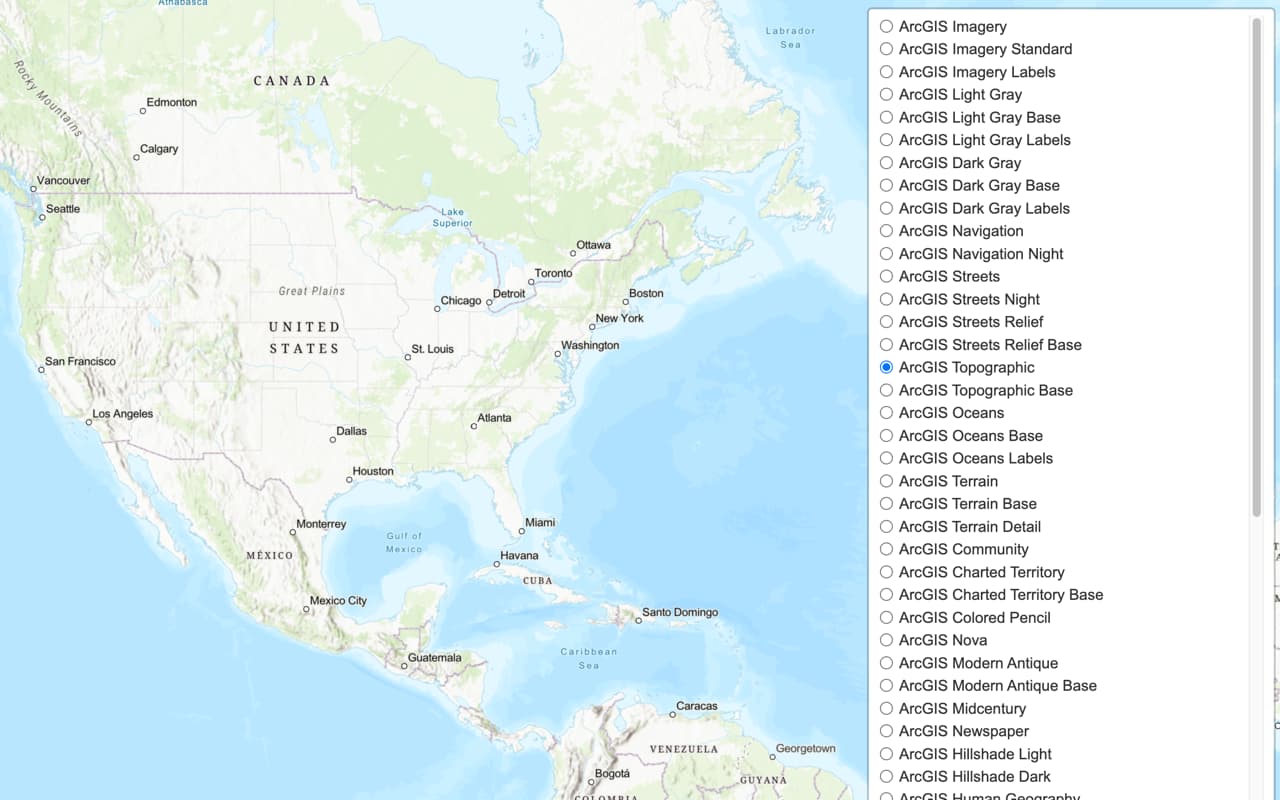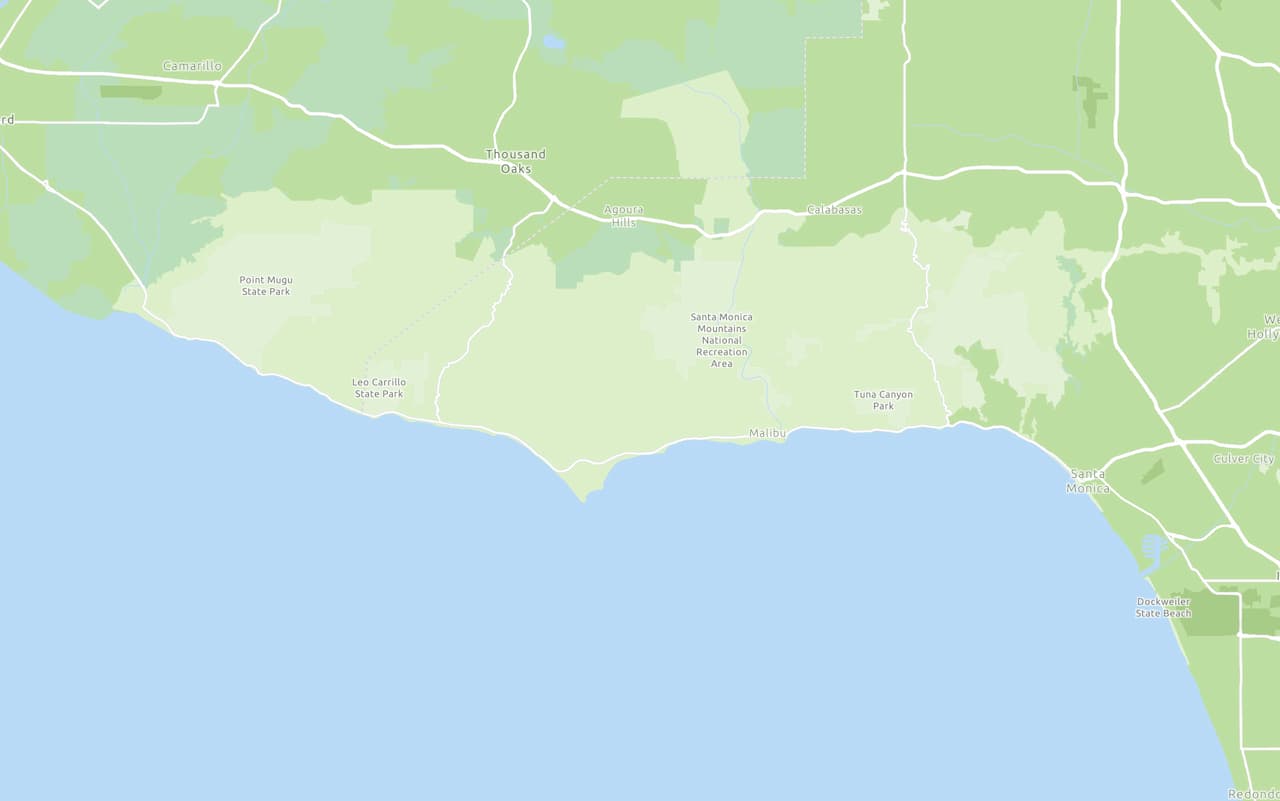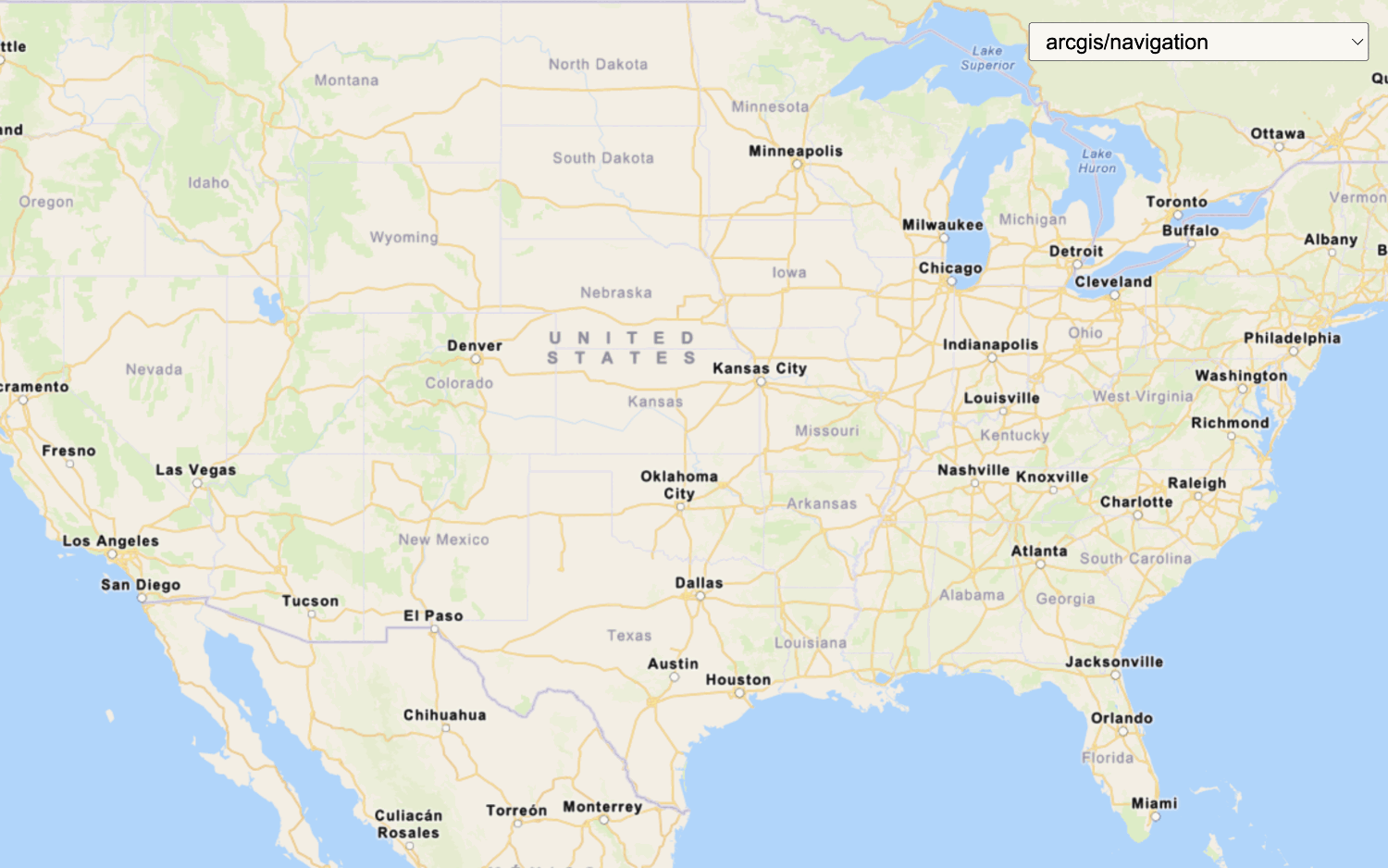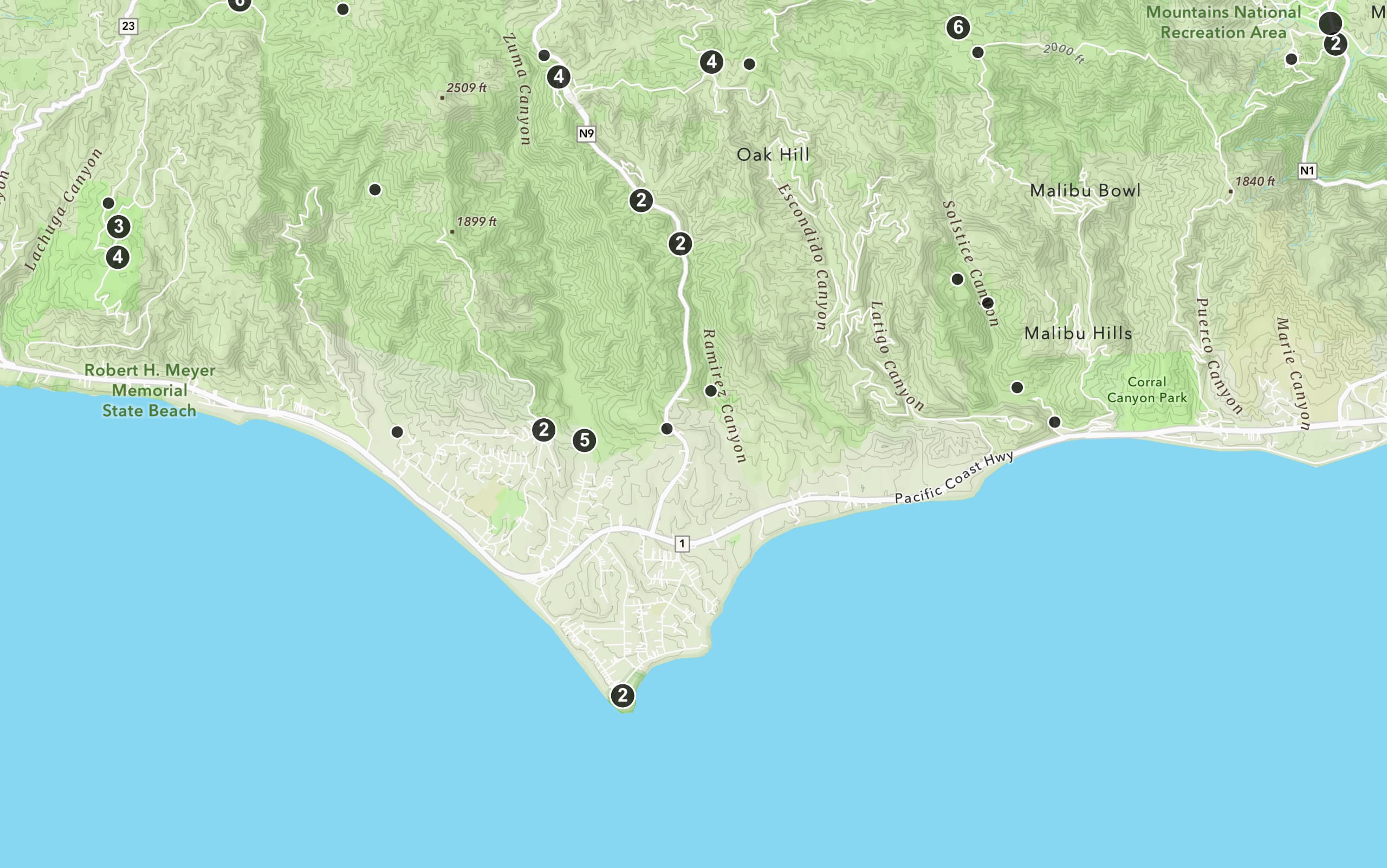Learn how to change language labels in a map.
The ArcGIS Basemap Styles service provides a number of different styles that you can use in your OpenLayers applications. Each style accepts a language parameter, which allows you to localize place labels. There are currently over 30 different languages available.
In this tutorial, you use a <select dropdown menu to toggle between a number of different place label languages.
Prerequisites
You need an ArcGIS Location Platform or ArcGIS Online account.
Steps
Get the starter app
Select a type of authentication and follow the steps to create a new app.
Choose API key authentication if you:
- Want the easiest way to get started.
- Want to build public applications that access ArcGIS Location Services and secure items.
- Have an ArcGIS Location Platform or ArcGIS Online account.
Choose user authentication if you:
- Want to build private applications.
- Require application users to sign in with their own ArcGIS account and access resources their behalf.
- Have an ArcGIS Online account.
To learn more about both types of authentication, go to Authentication.
Set up authentication
Set developer credentials
Use the API key or OAuth developer credentials so your application can access ArcGIS services.
Remove basemap references
-
Remove the
basemap,Id basemap, and theURL olmsfunction.Use dark colors for code blocks <script> /* Use for API key authentication */ const accessToken = "YOUR_ACCESS_TOKEN"; // or /* Use for user authentication */ // const session = await arcgisRest.ArcGISIdentityManager.beginOAuth2({ // clientId: "YOUR_CLIENT_ID", // Your client ID from OAuth credentials // redirectUri: "YOUR_REDIRECT_URI", // The redirect URL registered in your OAuth credentials // portal: "https://www.arcgis.com/sharing/rest" // Your portal URL // }) // const accessToken = session.token; const map = new ol.Map({ target: "map" }); map.setView( new ol.View({ center: ol.proj.fromLonLat([-20, 30]), zoom: 3 }) ); const basemapId = "arcgis/outdoor"; const basemapURL = `https://basemapstyles-api.arcgis.com/arcgis/rest/services/styles/v2/styles/${basemapId}?token=${accessToken}`; olms.apply(map, basemapURL) .then(() => { // Add Esri attribution // Learn more in https://esriurl.com/attribution const source = map.getLayers().item(0).getSource(); const poweredByEsriString = "Powered by <a href='https://www.esri.com/en-us/home' target='_blank'>Esri</a> | "; const attributionFn = source.getAttributions(); if (attributionFn) { source.setAttributions((ViewStateLayerStateExtent) => { return [poweredByEsriString, ...attributionFn(ViewStateLayerStateExtent)]; }); } else source.setAttributions(poweredByEsriString); }); </script>
Add a language selector
Add a menu that allows users to change the display language of your map. OpenLayers does not have a built-in selector widget, so you will create an HTML <select element.
-
In the
<headtag, add CSS that will position the> <selectmenu wrapper element in the upper right corner and provide styling.> Use dark colors for code blocks <style> html, body, #map { padding: 0; margin: 0; height: 100%; width: 100%; font-family: Arial, Helvetica, sans-serif; font-size: 14px; color: #323232; } #languages-wrapper { position: absolute; top: 20px; right: 20px; } #languages { font-size: 16px; padding: 4px 8px; } </style> -
In the
<bodyelement, add the wrapper tag with an id of> languages-wrapper.Use dark colors for code blocks <body> <div id="map"></div> <div id="languages-wrapper"> </div> -
In the wrapper element, add a
<selectelement, which you will populate in a later step.> Use dark colors for code blocks <div id="languages-wrapper"> <select id="languages"></select> </div>
Set the initial language
When the page loads, initialize the app to initially display in Ukrainian.
-
Create a function called
urlthat creates the URL for a basemap style.Use dark colors for code blocks <script> /* Use for API key authentication */ const accessToken = "YOUR_ACCESS_TOKEN"; // or /* Use for user authentication */ // const session = await arcgisRest.ArcGISIdentityManager.beginOAuth2({ // clientId: "YOUR_CLIENT_ID", // Your client ID from OAuth credentials // redirectUri: "YOUR_REDIRECT_URI", // The redirect URL registered in your OAuth credentials // portal: "YOUR_PORTAL_URL" // Your portal URL // }) // const accessToken = session.token; const map = new ol.Map({ target: "map" }); map.setView( new ol.View({ center: ol.proj.fromLonLat([48.8790, 35.7088]), zoom: 3 }) ); const baseUrl = "https://basemapstyles-api.arcgis.com/arcgis/rest/services/styles/v2/styles"; const url = (language) => `${baseUrl}/arcgis/outdoor?token=${accessToken}&language=${language}`; -
Create a function called
setthat will clear existing basemap layers and useLanguage olmsto instantiate a basemap layer in the new language.Use dark colors for code blocks const baseUrl = "https://basemapstyles-api.arcgis.com/arcgis/rest/services/styles/v2/styles"; const url = (language) => `${baseUrl}/arcgis/outdoor?token=${accessToken}&language=${language}`; const setLanguage = (language) => { // Clear out existing layers. map.setLayerGroup(new ol.layer.Group()); // Instantiate the given basemap layer. olms.apply(map, url(language)) .then(() => { // Add Esri attribution // Learn more in https://esriurl.com/attribution const source = map.getLayers().item(0).getSource(); const poweredByEsriString = "Powered by <a href='https://www.esri.com/en-us/home' target='_blank'>Esri</a> | "; const attributionFn = source.getAttributions(); if (attributionFn) { source.setAttributions((ViewStateLayerStateExtent) => { return [poweredByEsriString, ...attributionFn(ViewStateLayerStateExtent)]; }); } else source.setAttributions(poweredByEsriString); }); }; -
Access the
<selectelement using its id.> Use dark colors for code blocks const basemapsSelectElement = document.querySelector("#languages"); -
Import
arcgisto make a request to the Basemap Styles service. This dynamically fetches the available basemap languages and populates theRest.request() selectelement.Use dark colors for code blocks <!-- REST JS --> <script src="https://unpkg.com/@esri/arcgis-rest-request@4/dist/bundled/request.umd.js"></script>Use dark colors for code blocks arcgisRest.request(`${baseUrl}/self`, { httpMethod: "GET" }).then((response) => { response.languages.forEach((language) => { const option = document.createElement("option"); option.value = language.code; option.textContent = language.name; basemapsSelectElement.appendChild(option); }); });
-
Call
setto initialize the basemap layer to the Ukrainian (Language uk) enumeration.Use dark colors for code blocks arcgisRest.request(`${baseUrl}/self`, { httpMethod: "GET" }).then((response) => { response.languages.forEach((language) => { const option = document.createElement("option"); option.value = language.code; option.textContent = language.name; basemapsSelectElement.appendChild(option); }); setLanguage(response.languages[0].code); });
Add an event listener
Call set when the user selects an option in the <select menu.
-
Add an event listener that calls
setwhen theLanguage <selectelement is changed.> Use dark colors for code blocks const basemapsSelectElement = document.querySelector("#languages"); arcgisRest.request(`${baseUrl}/self`, { httpMethod: "GET" }).then((response) => { response.languages.forEach((language) => { const option = document.createElement("option"); option.value = language.code; option.textContent = language.name; basemapsSelectElement.appendChild(option); }); setLanguage(response.languages[0].code); }); basemapsSelectElement.addEventListener("change", (e) => { setLanguage(e.target.value); });
Run the app
Run the app.
Use the layer switcher menu at the top right to select and explore different basemap layer styles.What's next?
Learn how to use additional location services in these tutorials:



